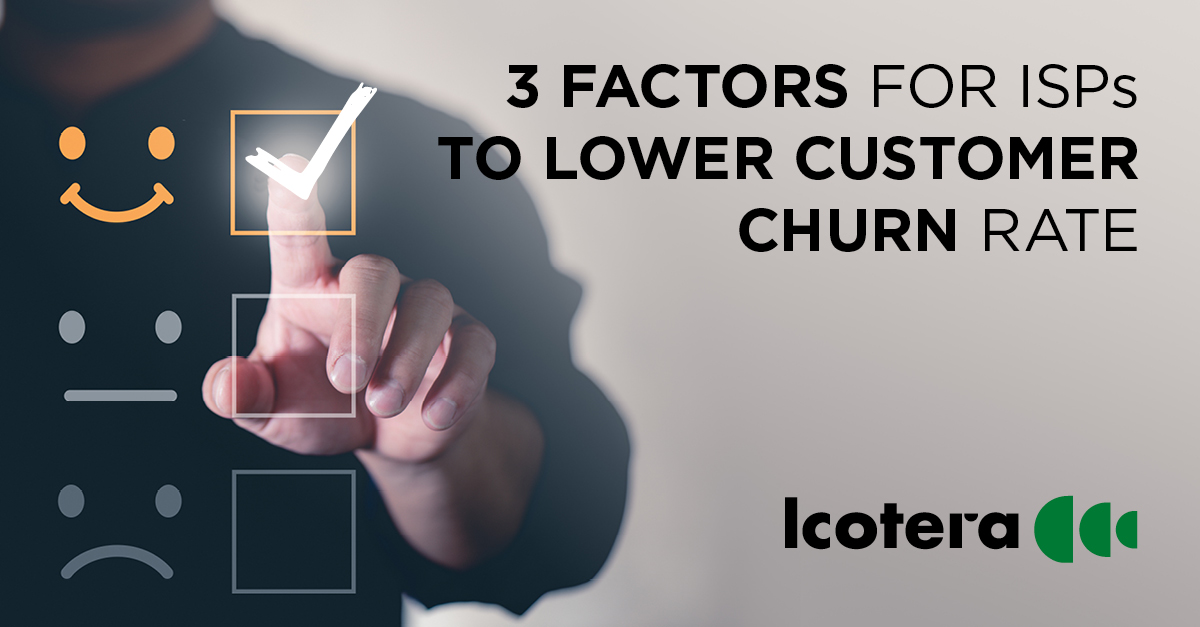The cost of gaining a new customer is generally high for an ISP. Therefore, a low churn rate is central to a profitable business and finding the right formula to retain customers is all important to success. The question is how to do this in a market characterized by fierce competition and with a shifting business case?
There is no denying that for the ISP industry in general, customer churn is a problem that even the most successful ISPs cannot escape. And no matter the size or revenue of your business, losing a customer is a costly affair.
- Of course, there will always be a base customer churn rate for ISPs due to customers changing addresses. This kind of churn is natural. But one kind of churn can pose a particular threat to the business: losing customers due to increased competition or because your customers are simply not satisfied with your service, says Erik Søe-Pedersen, Chief Commercial Officer (CCO) at Icotera.

“... your primary focus should of course always be your core service. You can’t compensate for poor quality in your core product – the internet subscription – with service add-ons. In a market with fierce competition, you must deliver a high-quality service at all times if you want to retain customers.”
–Erik Søe-Pedersen, Chief Commercial Officer, Icotera
Ensure customer stickiness
In times where the business case for ISPs is shifting, holding on to customers is not exactly getting easier. The primary reason is that the movement away from the traditional triple play service with both flow TV and landlines has been reduced to a single-play internet subscription. This challenges customer stickiness, because experience shows that customer loyalty towards a single-play service is lower than if a customer buys more services from the same supplier.
According to Erik Søe-Pedersen, this explains the tendency amongst ISPs to offer new secondary services together with the internet.
- Today, many ISPs try to attract customers with monthly subscriptions to music streaming services, TV streaming services, podcast apps or similar. This is a classic marketing tactic and an obvious choice for ISPs. Historically, ISPs used to retain customers by offering combined services, and now they’re trying to create stickiness in the same way by offering new service add-ons, explains Erik Søe-Pedersen, and he continues:
- Without doubt, this tactic may convince some customers to choose your service over competitors. Having said that, your primary focus should of course always be your core service. You can’t compensate for poor quality in your core product – the internet subscription – with service add-ons. In a market with fierce competition, you must deliver a high-quality service at all times if you want to retain customers.
Three ways of holding on to customers
According to Icotera, there are three factors to look at if you want to lower your customer churn rate:
#1 High speed - low latency Wi-Fi
Today, end-users are dependent on smooth internet performance, and they expect their ISP to deliver high speeds and low latency to every corner of their home.
- When ISPs ensure good coverage throughout the home, their customers will most likely remain loyal. But it also requires that you deliver a service beyond a plug in the wall, because if your service is just that customers are very little dependent on you, Erik Søe-Pedersen explains.
The CCO stresses that if you want to offer premium internet performance, high-quality customer premise equipment (CPE) is crucial. A poor-quality router could mean that, although the end-consumer is buying a high-Mbit connection, the result is much lower speeds in some areas of the home. And that is where the problem starts:
- Every ISP knows that troubleshooting and support can be a costly affair. Generally, high-quality CPE needs less support, and this benefits both the customer experience and the profitability of your business. You can be certain that a low-quality router will require more support. Even for ISPs offering Wi-Fi at a low monthly rate, a high-end router is important for this reason.
#2 Less is more
Often, a mesh solution with up to three or five units is promoted as the miracle cure for poor in-home internet performance. This has caused a general misconception of the more the merrier.
This is not necessarily true.
- The minute you connect more units to your network, regardless of whether they’re mesh units or extenders, complexity increases and so do chances of breakdowns, simply because there are more possible sources of errors, Erik Søe-Pedersen says.
Therefore, the CCO always advises ISPs to prioritize overall simplicity.
- It’s much better to strive to deliver a simple solution with one high-end router to do the job, covering the entire home. One single high-end router can easily replace five average mesh units. For the ISP, there’s a great difference in setting up, monitoring, and supporting a simple versus a complex solution.
#3 Insight is key
There is no doubt that poor internet performance causes a lot of frustration with end-users who often see no other choice than to reach out to the service provider’s help desk. A help desk call is not a problem in itself, but it becomes a problem if the response is not effective.
That is why Icotera advises ISPs to have an in-home monitoring system in place. Such a system provides data-driven insight and makes it much easier to offer support, ensuring high customer satisfaction and low churn.
>>> Want to know more about how in-home monitoring can pave the way for greater customer satisfaction? Read more in this blog post: How in-home monitoring is paving the way for greater customer satisfaction
However, according to Erik Søe-Pedersen, it is not only a matter of having the system; how you employ it is also important.
- To realize the system’s full potential, you have to make it a priority. It doesn’t do much good just looking into the system once in a while. You need to scrutinize it and take proactive action when needed. The resources you put in it define whether you will only be able to use the system ad-hoc or whether you will be able to realize its full potential.
He provides an example:
- I recently talked to an ISP who had managed to increase his Net Promoter Score, a metric for customer satisfaction, by 19 % after investing in an in-home monitoring system. This example tells a lot about the potential of these systems in terms of driving up customer satisfaction and in the end lowering churn.
The CCO admits that there are important things to consider when engaging in proactive support.
- Reaching out to an end-user because you can see she had performance issues when streaming a movie the night before might not be the right approach if the customer has not signed up for these services. But making adjustments to some parameters of the router is different. You need a clear strategy for how to use your in-home monitoring system, because of the ethical question in monitoring people’s homes. But done right, there is a huge potential here, Erik Søe-Pedersen concludes.
![]()
Want to know more about how Icotera’s services can help you lower customer churn? ? Feel free to contact our Chief Commercial Officer (CCO) Erik Søe-Pedersen at esp@icotera.com
-----------------------------------------------------------------
Interested in HOW your ISP business can stay ahead?
In this e-book, we look into how choosing the right business strategy and using customer data to deliver a proactive customer experience are two ways that will help you build a strong business case. And much more... Download our new E-book: The competitive ISP here

